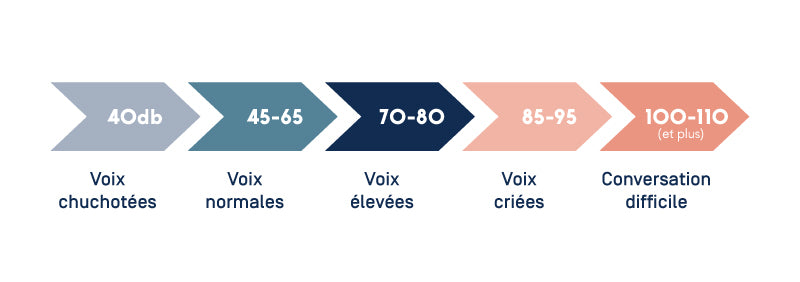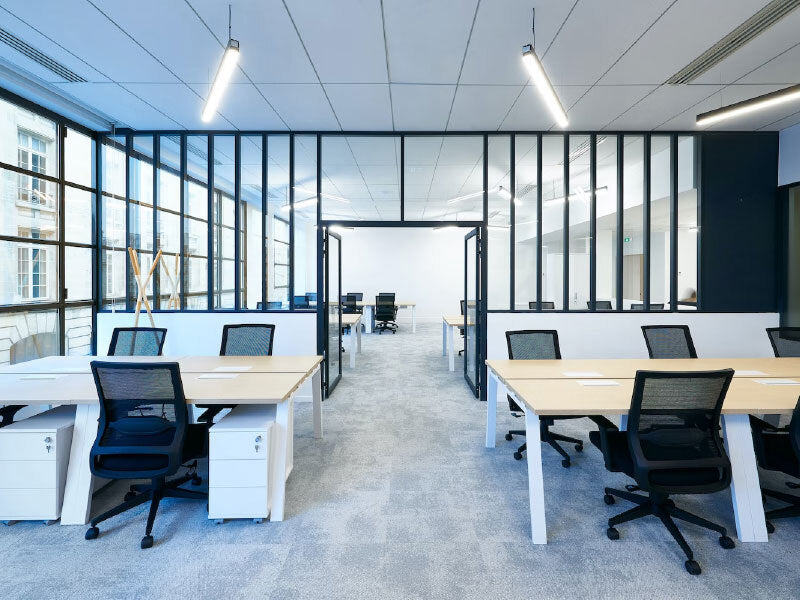Lack of soundproofing can lead to stress, insomnia and hearing fatigue among employees. It is therefore crucial for a company to find solutions to improve soundproofing and create a pleasant working environment, and acoustic cabins can play an important role in this.
The optimum noise level to be respected
According to international regulations, the unit of sound measurement is the decibel (dB). In terms of occupational safety, noise greater than or equal to 80 dB is considered a hearing hazard. These conditions are most often experienced in industry and construction or public works companies.

In the specific case of the teleworking office, the sound environment should never exceed 50dB. To get a clear idea, note that a television emits about 70 dB representing its average sound level. If you work remotely, your living room is therefore not the ideal place to set up your workspace.
The main sources of noise pollution
Bruits externes : Une bonne isolation thermique et phonique des murs protège contre les bruits de rue ou de voisinage. Ces traitements peuvent être intégrés lors de travaux d’isolation pour réduire les coûts.
Bruits internes : Réduire les sons émanant des pièces adjacentes ou de la famille est essentiel, notamment lors de téléconférences. Des précautions comme des portes insonorisées et la sensibilisation des proches sont importantes.
Bruits dans l’espace de travail : Les sons générés à l’intérieur du bureau, comme les échos dans une pièce vide, nécessitent des solutions telles que des panneaux acoustiques ou des tapis absorbants.
Les solutions efficaces pour l'isolation phonique de vos locaux
Un espace de travail bien isolé doit intégrer des solutions adaptées aux plafonds, murs et sols :
- Murs et plafonds : Les panneaux acoustiques, baffles et toiles tendues sont efficaces pour absorber les sons et réduire leur propagation.
- Cloisons acoustiques : Disponibles en versions mobiles, vitrées ou pleines, elles permettent de délimiter les espaces tout en réduisant les bruits ambiants.
- Sols : Une moquette dense peut réduire les bruits de pas ou d’impact de 20 à 40 dB, offrant un confort sonore supplémentaire.

Improve acoustic comfort by soundproofing the walls
This work is generally the work of an acoustician. In order to reduce noise pollution to its simplest expression, your acoustician can proceed with the insulation of all the sides of your workspace identified as too noisy. these are, for example, the floor, the ceiling and also the walls.
Effective fight against noise pollution
Improve the ceiling to limit the transmission of airborne noise
Acoustic insulation also requires the use of furniture adapted to the ceilings. For example, the acoustic panel can be used to attenuate ambient sound. On the market, the designs of each panel are always more innovative by their solidity and their beauty on the one hand, but also and above all by their acoustic efficiency.
Use of the acoustic panel
As the name suggests, movable panels are freestanding acoustic devices. they allow the isolation of individual spaces and the reduction of ambient sound levels. These panels also have the particularity of allowing the creation of individual boxes or cabins, useful for the concentration of each professional on his objectives.
Use of the acoustic panel for walls
The wall acoustic panel allows excellent acoustic correction by avoiding the repercussion of sounds on the walls. This helps to effectively absorb noise.
Strategic choice of office location
Reducing the noise pollution caused by noise is essential in all cases. The location of the office can contribute to this end. Moving the latter away from preferential trading areas is therefore important. When the office is moved away from traffic areas such as entrances or colours, this helps to attenuate the sound during employee working hours.
Pour conclure
Every employee dreams of a peaceful workplace, pleasant for communication and well-being. To achieve this, optimal acoustic comfort is essential. The use of acoustic booths can help reduce harmful noises that can compromise the operation of the company as well as the health of the workers. Lack of soundproofing can lead to stress, insomnia and hearing fatigue among employees. It is therefore crucial for a company to find solutions to improve soundproofing and create a pleasant working environment, and acoustic cabins can play an important role in this.





